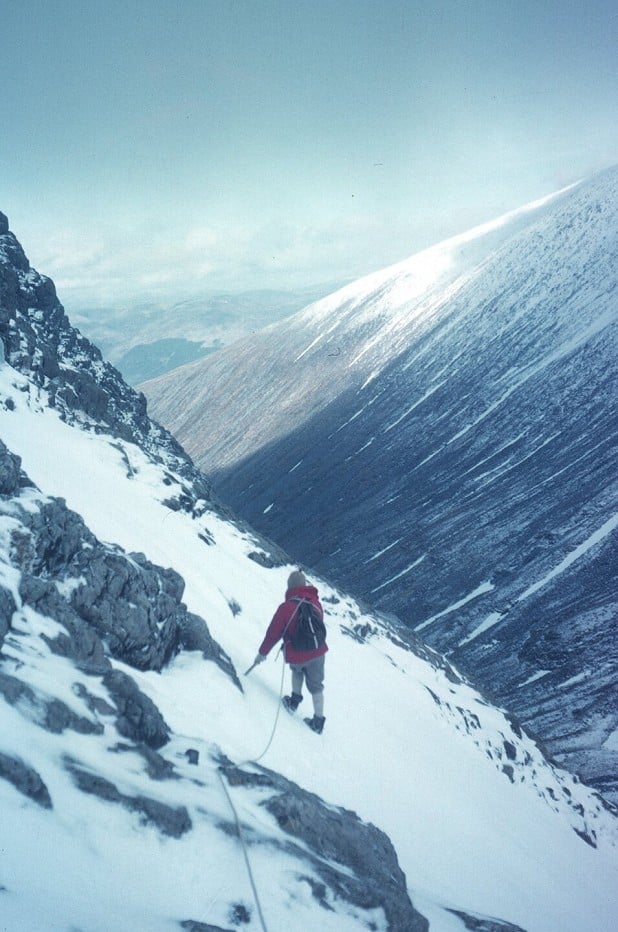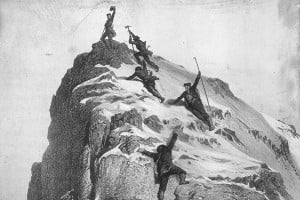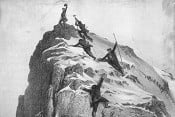
Gwen Moffat shares a story about a salutary walk to the CIC hut in the fifties...
There were snow clouds in the north and only an hour of daylight left. The path was no more than a three-mile trudge to the hut but I was loaded with gear and food for a week's climbing. Progress was slow, the light was failing and the northern clouds shifted south, sinking to settle on the Ben. There was no sunset. A vagrant breeze wandered about and yet the air seemed heavy, pregnant and alien.
I came to the top of the steep section as the first flakes began to fall but now there were only two miles to go to shelter and no more than a gradual rise up the bottom of a glen that was dead straight. What could go wrong? There was no reason why these chance flurries, a rising wind and approaching night should produce unease and I didn't consider turning back even when the snow started to obscure old tracks.
The world changed in the seconds it took for the front to strike. The wind turned gusty, strengthening to storm force and driving spiculae into my face, crusting my glasses. I took them off and my headlight shone on a shining screen like a waterfall swaying with the wind. My load was forgotten, all concentration on the attempt to find a focal point: a rock, a clump of dead grass - but nothing showed, only snow.
The ground became rougher with altitude. I lost the track. I knew that, knew too that I must keep well clear of the burn because it ran between short walls and a fall of only a few feet could concuss, and concussion would be fatal in these conditions, particularly if I went through the ice into the water.
I got mixed up with the old glacial moraines and the wind would meet me on a crest and send me sideways. Several times the rucksack pulled me down. Partly I was tired but mostly it was the weight on my back and the lack of balance: I couldn't rise until, as if on skis, I had got my feet downhill when I could lever myself upright with the help of the axe. Then there were the drops in the vicinity of the moraines; progress was tactile rather than visual: feeling with the feet when there were only occasional glimpses of my boots.
Sometimes I switched off the light and waited, trying to get the line of the hills against the sky, to get my bearings. It was essential not to pass the hut. But I didn't like standing still in the dark; there was no support, no human sound, only a dull roar that could be the wind in the summit cliffs and the closer whisper of snow on snow.
I went past fear, even unease; there was no calculation, only an urgency to keep moving, not to stop. After a while, as if I were drinking or drugged, a new mood came and I considered safety: the sensible course would be to find a good boulder, a shelter stone, to pull out my duvet and lovely down bag and go to sleep. Energy would be recouped. There was no thought of the friends and all the other lost and unknown souls who had done that and died. I felt no pain, no discomfort, I just wanted to get out of it, to give up and find oblivion in a drift.
Then an idea occurred. Had I missed the hut? Where the hell was I? A mile beyond it, in that last bleak corrie under the headwall? There was no light, but then of course no light would show through the blizzard. I had a whistle. I had never blown it for myself. The thought of hearing those sinister blasts so close made me cringe in horror. It would be an admission of emergency – worse, of incompetence.
I went on, but survival won; I found the whistle and started to blow.
It was astonishing how much breath was needed and how thin was the sound produced. I didn't signal. I just blew. Then I stopped and listened.
There was no answer.
I started forward and stopped, panting hard and desperate: more so than before I had appealed for help.
As I moved once again despair drained away leaving me without emotion. There was no fear and no guilt; I didn't think I was going to live, nor did I think I would die. I didn't think of my family. I didn't care. I moved slowly, deliberately, the light shining ahead on the snow.
It was a while before I realised that it was shining on snow on the ground, not on the falling white wall of the last few hours. I couldn't believe it. I planted my feet for balance, switched off the torch and waited.
High, very high above, there was a star or two – no silhouette of hills for the cloud was on them but torn apart above the glen. The wind had died down here. Calm and relaxed and drained by exhaustion I looked for the hut and saw it below me and slightly ahead: the faint yellow glow of a single window bringing me in from the dark of the gathering night.
- ARTICLE: A 1959 DIY Mountain Rescue on Ben Nevis, by Gwen Moffat 3 Dec, 2020
- ARTICLE: Gwen Moffat on Diocese 14 Sep, 2020
- ARTICLE: Winter as it Was - The Helm Wind 24 Dec, 2018
- ARTICLE: Gwen Moffat - Thoughts on viewing Psycho Vertical 19 Dec, 2017













Comments
I can still recall reading this 50 years ago. A short while later I had the same experience walking up to the CIC one December night in the dark and blowing snow. Around 2am we decided to kip down in the heather and snow and wait until it got light. A quick breakfast at the hut then a very slow ascent of the NEB, followed by a retreat from high up as the weather got even worse!
I should perhaps add that the next day was even worse as Glovers was followed by an adventure in 5 Fingers in a full on blizzard!
Don't you just love the Scottish winter!
I guess the old adage “What doesn’t kill you makes you stronger” is the desired outcome!
What possibly could go wrong walking up to the CIC hut...it's a bit like me and mate crossing the Abhainn Srath na Sealga,it raining for 8hrs solid and we had left all our gear in the Shenavall bothy......Scotland never to be underestimated..
After two incidences which could have got serious I vowed never to leave my pack.
First, on the Appalachian Trail I left my gear in a shelter and went down to get water; it was much further than I thought. I looked up and thought I hope to hell I can find my way back,. Why does it all look so different on your return journey and it gets darker quicker than you think. I thought it could be a long cold night, success in the end. Break twigs and overturn rocks to leave a trail is a thought. Native Americans sometimes marked such a trail with a hatchet swipe on trees.
Second time was when I walked the Rob Graham Round. So that I could run up and down Seat Sandal and Fairfield I Ieft my pack in a bracken clump in between the two summits. I even left a twig arrow not far from my gear. When I finished I looked for my gear and then saw just how many bracken clumps there were. I searched and eventually found the pack. A lesson learnt.
Now if I ever left anything I would take an accurate, long grid reference, take a photograph of the location and at least take rain gear with me so sleeping out might just be possible.
y
And the track up from the distillery and above used to be a mud morass!